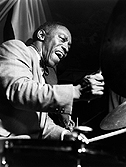 |
Art BlakeyDrums |
|---|
 |
Art BlakeyDrums |
|---|
"The [Wayne Shorter] edition of the Messengers stood out as the most captivating mainstream jazz combo if its day."
--Ted Gioia
It's not often enough realized how useful Art Blakey has been as an encourager of the young. He has always, for example, urged anyone in his group to write, and has promised to try out any chart any band member brings to rehearsal. Benny Golson was established before he joined Blakey, but Benny gained useful experience and had free play as Art's musical director. Other writers who have used Blakey bands as a laboratory have been Horace Silver, Donald Byrd, Hank Mobley, and Jackie McLean.
Being with Blakey can be one of the most valuable apprenticeships in jazz for players and writers. If you have capacity, the constant challenge of Art's own ceaseless force and rhythmic demands will accelerate your awareness of how much you can do. If you don't have it, Art's pace will quickly become too much, too overwhelming for you.
--NAT HENTOFF, from the liner notes,
The Big Beat, Blue Note.
You couldn't write enough music for Art. You'd write it now, you'd get it played now, and you'd get it recorded now. You can't ask for anything more, being an instrumentalist.
Art Blakey was an education. You could apply everything you'd ever known about music. He would beg you to write, he would insist on it, he would hire you because you were a writer. The group would play my music fast! They played it faster than I could. I said, 'Wait a minute. I wrote this thing.' People used to attend our rehearsals in New York. Word would get out that the group was rehearsing and you'd have an audience sitting there. It was nice.
--CEDAR WALTON, interview with Gene Lees,
Cats Of Any Color.
After Golson's departure, Blakey hired tenorist Hank Mobley for a spell, recording a pungent nightclub performance, under the title At the Jazz Corner of the World, during this period. The addition of saxophonist Wayne Shorter later in the year initiated a new expansion in the scope of the band, which was solidified by the arrival of trumpeter Freddie Hubbard and pianist Cedar Walton in 1961. Shorter's elliptical manner of improvising and composing would come to exert a decisive influence on the Messengers, signaling a break with the rhythm-and-blues orientation of the Morgan/Timmons/Golson unit.
With Hubbard and Shorter fronting the band, Blakey electrified audiences and produced a series of outstanding recordings, including Caravan, Kyoto, Three Blind Mice, and Ugetsu. Already a solid soloist, Shorter blossomed as a composer during his Blakey years. "This is for Albert," "Lester Left Town," and other Shorter contributions bespoke a far greater sophisitication than Blakey's late 1950's repertoire. Hubbard's extroverted improvisations served as an attractive foil for Shorter's moody lines, while the addition of trombonist Curtis Fuller created a three-horn front line that added depth to the Messengers' sound. Over fifteen years would elapse before a Blakey band, then fronted by Wynton and Branford marsalis, would cause such a stir on the jazz scene.
--TED GIOIA, The History Of Jazz.
A selected discography of Art Blakey albums.
| Find Art Blakey on Amazon.com | Find Art Blakey on eBay.com | |
|---|---|---|
| Art Blakey CDs on Amazon | Art Blakey CDs on eBay | |
| Art Blakey DVD / VHS on Amazon | Art Blakey LPs on eBay | |
| Art Blakey BOOKs on Amazon | Art Blakey DVD / VHS on eBay | |
| Art Blakey BOOKs on eBay |
 Music |
 Home |
 Musicians |
|---|
|
Any comments, additions or suggestions should be adressed to:
The Hard Bop Homepage / Eric B. Olsen / ebolsen@juno.com |
Other Web Sites:
The Film Noir 'net A History of Horror The War Film Web Author Eric B. Olsen |